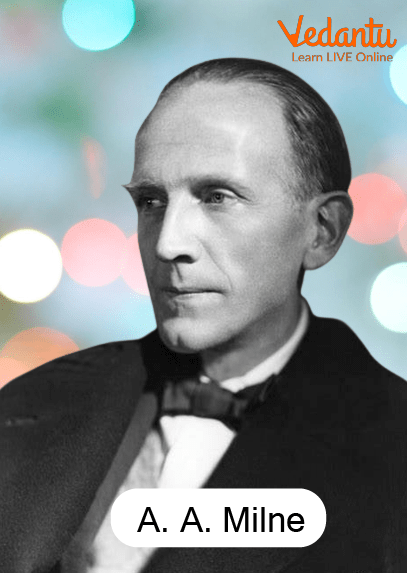Buttercup Story by A. A. MILNE
The Poet
Alan Alexander Milne (/mɪln/; 18 January 1882 - 31 January 1956) was an English writer famous for his books about the teddy bear Winnie-the-Pooh and kids' verses. Milne was basically a dramatist before the tremendous progress of Winnie-the-Pooh eclipsed all his past work. Milne served in both World Wars, serving in the vitally British Army in the First World War and as a commander of the British Home Guard in the Second World War.

A.A.MILNE
Milne was the father of book retailer Christopher Robin Milne, upon whom the person Christopher Robin is based. It was during a visit to London Zoo, where Christopher became captivated with the manageable and pleasant bear Winnipeg, that motivated Milne to compose the story for his son.
Poem
Where is Anne?
Head above the buttercups,
Walking by the stream,
Down among the buttercups.
Where is Anne?
Walking with her man,
Lost in a dream,
Lost among the buttercups.
What has she got in that little brown head?
Wonderful thoughts which can never be said.
What has she got in that firm little fist of hers?
Somebody's thumb, and it feels like Christopher's.
Where is Anne?
Close to her man.
Brown head, gold head,
In and out the buttercups.
Buttercup Story By Mary Howitt
The Poet
Mary Howitt (née: Botham; 12 March 1799 - 30 January 1888) was an English artist, the creator of the popular sonnet The Spider and the Fly. She deciphered a few stories by Hans Christian Andersen. A portion of her works was written related to her significant other, William Howitt. Many, in stanza and composition, were expected for youngsters.

Mary Hawitt
Mary Botham, the little girl of Samuel Botham and Ann (née Wood), was brought into the world at Coleford, Gloucestershire, where her folks resided briefly, while her father, a prosperous Quaker assessor and previous rancher of Uttoxeter, Staffordshire, cared for some mining property. In 1796, 38 years old, Samuel had hitched 32-year-old Ann, a girl of a Shrewsbury lace weaver. They had four kids: Anna, Mary, Emma, and Charles. Their Queen Anne house is currently called Howitt Place. Mary Botham was instructed at home, read generally, and started composing refrains at an early age.
Poem
Buttercups and daisies,
Oh, the pretty flowers,
Coming ere the springtime,
To tell of sunny hours.
While the trees are leafless,
While the fields are bare,
Buttercups and daisies
Spring up here and there.
Ere the snowdrop peepeth,
Ere the crocus bold,
Were the early primrose
Opes its paly gold,
Somewhere on the sunny bank
Buttercups are bright;
Somewhere 'among the frozen grass
Peeps the daisy white.
Little hardy flowers,
Like to children poor,
Playing in their sturdy health
By their mother's door,
Purple with the north wind,
Yet alert and bold;
Fearing not, and caring not,
Though they are a-cold!
What to them is winter!
What are stormy showers!
Buttercups and daisies
Are these human flowers!
He who gave them hardships
And a life of care,
Gave them likewise hardy strength
And patient hearts to bear.
Poem By RJ Smith
RJ Smith is an Emmy Swag Recipient, American Optioned Screenwriter, and Contemporary Horror Novelist of nail-gnawing Mystery/Suspense/Thrillers with underhanded story improvement. The essayist is most popular for his novel way of fostering a story, pioneering a path of the cutting edge story by blending his involvement with Hollywood composing SPEC symbolism with scholarly structure making the peruser feel as though they are listening in!
Noted by Francis Ford Coppola American Zoetrope Studios, The Page International Screenwriting Awards, The Emmy Swags and Sundance Table Read My Screenplay, RJ is addressed by NYC artistic specialist Joyce Keating, London's Robert Snow and Hollywood Manager Julie Stern.
Poem
Hello there my buttercup
Your petals are so fine
So fragile in the morning sun
How brightly you shine!
Off to face my busy day
And now a cheery fellow
Above you first I’ll hold my chin
To turn the petals yellow!
Summary
Clarification In the glades, it is possible to run over a butterfly easily positioned upon her buttercup or blossoms brimming with nectar. Apparently, the butterfly is tasting nectar from the buds and blossoms with the assistance of a drinking straw.


FAQs on Buttercup Poems
1. What does the poet name the buttercup? Why?
The poet says that the meadows are full of novelties and bounty. He additionally says that someone who is a keen observer of nature can feel the beauty of nature and enjoy the greenery that surrounds him. The poet has superbly used figures of speech within the poem. He makes use of the word ‘buttercup’ for plants and buds. He calls the plants and buds buttercups due to the fact they provide a number of candy nectar to the butterflies and they are able to fortuitously sip the nectar from them. A butterfly is considered to be a completely beautiful insect and has a long and thin frame. It has a very thin pipe-like mouth which it makes use of to sip the nectar from the vegetation and buds.
2. What is a Buttercup?
Buttercup is a commonplace call for the whole Ranunculus genus, which belongs to the Ranunculaceae circle of relatives. This huge genus consists of over 600 species and is local to North America and Eurasia. While this plant has a tendency to grow inside the wild, it’s widespread as ground cover as it's smooth to grow and gives a happy aesthetic to any yard.
Buttercups are available in small sizes with vibrant yellow flowers. Their paper-thin petals provide them a delicate attraction, making them a favorite in lots of wedding ceremony bouquets and floral arrangements.
3. What flower symbolizes anger?
The petunia symbolizes resentment and anger. It may be a striking flower, but its message is sure to get you into trouble.





